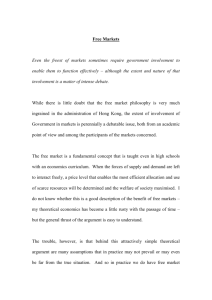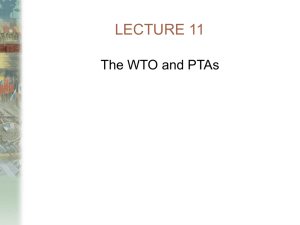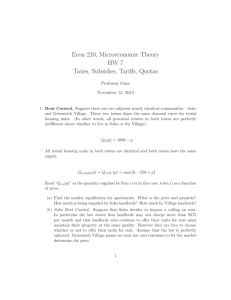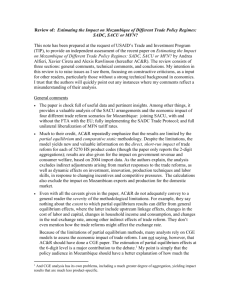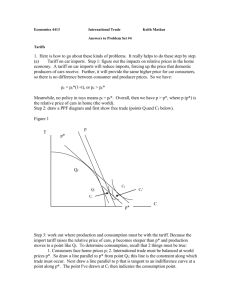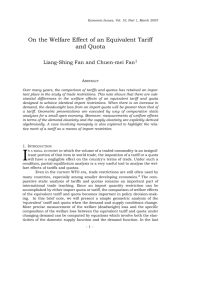Study Guide for Final Exam – Fall 2008
advertisement
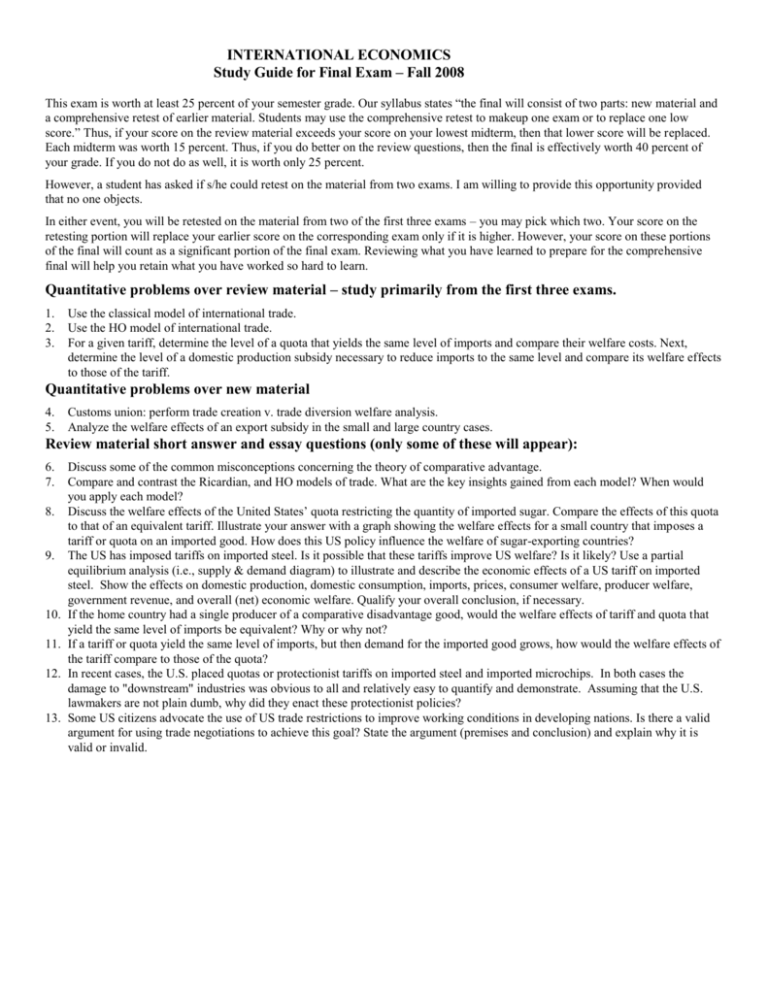
INTERNATIONAL ECONOMICS Study Guide for Final Exam – Fall 2008 This exam is worth at least 25 percent of your semester grade. Our syllabus states “the final will consist of two parts: new material and a comprehensive retest of earlier material. Students may use the comprehensive retest to makeup one exam or to replace one low score.” Thus, if your score on the review material exceeds your score on your lowest midterm, then that lower score will be replaced. Each midterm was worth 15 percent. Thus, if you do better on the review questions, then the final is effectively worth 40 percent of your grade. If you do not do as well, it is worth only 25 percent. However, a student has asked if s/he could retest on the material from two exams. I am willing to provide this opportunity provided that no one objects. In either event, you will be retested on the material from two of the first three exams – you may pick which two. Your score on the retesting portion will replace your earlier score on the corresponding exam only if it is higher. However, your score on these portions of the final will count as a significant portion of the final exam. Reviewing what you have learned to prepare for the comprehensive final will help you retain what you have worked so hard to learn. Quantitative problems over review material – study primarily from the first three exams. 1. 2. 3. Use the classical model of international trade. Use the HO model of international trade. For a given tariff, determine the level of a quota that yields the same level of imports and compare their welfare costs. Next, determine the level of a domestic production subsidy necessary to reduce imports to the same level and compare its welfare effects to those of the tariff. Quantitative problems over new material 4. 5. Customs union: perform trade creation v. trade diversion welfare analysis. Analyze the welfare effects of an export subsidy in the small and large country cases. Review material short answer and essay questions (only some of these will appear): 6. 7. 8. 9. 10. 11. 12. 13. Discuss some of the common misconceptions concerning the theory of comparative advantage. Compare and contrast the Ricardian, and HO models of trade. What are the key insights gained from each model? When would you apply each model? Discuss the welfare effects of the United States’ quota restricting the quantity of imported sugar. Compare the effects of this quota to that of an equivalent tariff. Illustrate your answer with a graph showing the welfare effects for a small country that imposes a tariff or quota on an imported good. How does this US policy influence the welfare of sugar-exporting countries? The US has imposed tariffs on imported steel. Is it possible that these tariffs improve US welfare? Is it likely? Use a partial equilibrium analysis (i.e., supply & demand diagram) to illustrate and describe the economic effects of a US tariff on imported steel. Show the effects on domestic production, domestic consumption, imports, prices, consumer welfare, producer welfare, government revenue, and overall (net) economic welfare. Qualify your overall conclusion, if necessary. If the home country had a single producer of a comparative disadvantage good, would the welfare effects of tariff and quota that yield the same level of imports be equivalent? Why or why not? If a tariff or quota yield the same level of imports, but then demand for the imported good grows, how would the welfare effects of the tariff compare to those of the quota? In recent cases, the U.S. placed quotas or protectionist tariffs on imported steel and imported microchips. In both cases the damage to "downstream" industries was obvious to all and relatively easy to quantify and demonstrate. Assuming that the U.S. lawmakers are not plain dumb, why did they enact these protectionist policies? Some US citizens advocate the use of US trade restrictions to improve working conditions in developing nations. Is there a valid argument for using trade negotiations to achieve this goal? State the argument (premises and conclusion) and explain why it is valid or invalid. You will be asked to answer at least one question similar to those listed below from each chapter. Chapter 8: 14. Compare and contrast safeguard provisions (the escape clause), trade adjustment assistance, and wage insurance. Which of these is most likely to be welfare improving? Support your conclusion. 15. Briefly describe the current policies the United States has in place to limit both fairly and unfairly traded goods. 16. What is dumping? What changes in static welfare occur as a result of dumping? Why would firms engage in dumping? Is predatory dumping likely to occur? Is it likely to succeed? Explain carefully. 17. What are the benefits and costs of U.S. antidumping laws? 18. Compare and contrast how the US government handles antidumping and countervailing duty cases. 19. What is Section 301 of US trade law? Describe how it works. Do you think it is likely to be very effective? Comment. 20. In 1988, Senator Ernest Hollings of South Carolina was quoted as saying that "going the 201 route is for suckers." By this, he appeared to mean that American firms seeking protection from foreign competition would do better by using other trade remedies. Given your knowledge of how Section 201 and alternate forms of U.S. trade laws are administered, do you agree with the Senator's statement? Why or why not? 21. What is the WTO? What services does it perform? Explain carefully. 22. Compare and contrast the Unconditional Most Favored Nation principle and national treatment. Chapter 9 , “EU External Trade Policy” by Brülhart and Matthews, and “Understanding the WTO”: 23. Distinguish among free trade areas, customs unions, common markets and economic unions. Where do NAFTA and the EU each fit in this spectrum? 24. Has the EU produced net benefits for its members? Has NAFTA? Support your conclusion. 25. Comment on the observation that the sign of a successful customs union is that world trade expands after it is formed. 26. Discuss the pros and cons of multilateral trade liberalization under the principle of unconditional MFN status versus the formation of regional trade arrangements. 27. What conditions are likely to lead to a trade-diverting customs union? . . . a trade-creating customs union? 28. Explain why trade diversion is considered bad and trade creation is considered beneficial? 29. Which of the theories we have studied best explains the growth of intra-EU trade? 30. How has the external trade of the EU shaped its specialization in high technology industries? 31. How has the external trade of the developed countries (including the EU) shaped their specialization in low-skilled intensive industries? Consider both its effects on wage differentials and unemployment rates. Refer to the literature discussed in the articles by Cline and by Brülhart and Matthews. 32. How has the EU’s Common Agricultural Policy affected world trade in agriculture? Consider (and diagram) its effects on other agricultural exporters as well as countries that import agricultural goods. 33. Discuss how the varying requirements for unanimity versus qualified majority voting in the EU may impede or enhance progress in multilateral trade negotiations (see Brülhart and Matthews). 34. What requirements do WTO rules impose on the formation of regional trade agreements (RTAs)? 35. How has the proliferation of regional trade agreements (RTAs) affected the practical meaning of Most Favored Nation status in the context of the EU’s external trade? 36. Explain the importance of rules of origin in the operation of RTAs. How has the EU dealt with their complexity? 37. Will the proliferation of RTAs lead to more trade creation or trade diversion? How does your prediction depend on progress (or lack thereof) in multilateral trade negotiations? 38. What are the estimates of the cost to the EU of its remaining external trade barriers? 39. How did the WTO agreement revise the dispute settlement understanding (DSU) procedures from the GATT? Have these changes improved the process? What are the major proposed revisions in the DSU in the Doha round? 40. Should trade policy be used as a tool to protect the environment? Summarize the arguments for and against this before stating you own views. 41. Do you think that incorporating labor standards into future trade agreements at the WTO is likely to speed or impede progress on the adoption of core labor standards? Summarize the arguments for and against such incorporation before stating you own views. 42. Do you think that the EU’s desire to strengthen the precautionary principle stems more from rational health concerns or from protectionism? My own view is that many people tend to worry too much about slight risks, such as hormone-treated beef, and not enough about proven risks, such as smoking, obesity, and a sedentary lifestyle. Thus, I believe that the EU ban on hormone-treated beef is inconsistent with their own behavior and likely motivated by protectionism – but you are free to disagree provided you present a valid, logical argument. 2








